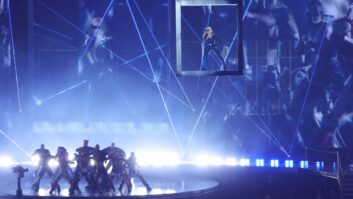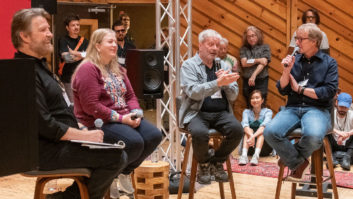At my first job working for a real sound company, I had the good fortune to be paired with the company’s senior engineer, Fred Mueller, who taught me what really counts in live sound. One game we played was taking turns equalizing the sound system, each doing a side. We used the mantra of, “Check, one, two” into a vocal mic. In the early days there were no Walkmans, laptops or affordable real-time analyzers, so being able to make critical adjustments by ear with this convenient, familiar sound source and using the vocal mic du jour was a critical skill. The response of the microphone, including its proximity effect, imparts a contour to the sound that makes the vocals in the system sound natural, but at the same time it colors the other inputs. Freddy would sometimes borrow the bass guitar to tune up the low end of the P.A. before the band showed up.
In the ’80s, the advent of the CD made it possible to play well-recorded tracks, such as Donald Fagen’s Nightfly, over the P.A. as a reference. With today’s CD-R technology, a custom compilation disc can be recorded with pink noise, tones, favorite cuts or even material from the act being mixed. And, of course, MDMs now allow engineers to hear individual tracks and build a mix from the previous night’s show before the band even shows up for soundcheck.
It’s possible to perform adequate system EQ adjustments by simply using your two ears and a good graphic equalizer. This, of course, assumes that:
1) Your ears aren’t destroyed from years in hyper-SPL environments, and
2) If you can still hear, you can correctly pick out anomalies in the response of the speakers in the room by just listening. You must identify the third-octave band to which a frequency aberration belongs and decide if one of the 30 filters can help. Alternatively boosting and cutting each slider on the graphic while hooting into a mic or playing favorite CDs eventually gets things sorted out. This has been done with varying results since live engineers began setting up concert sound systems, and it’s one reason for the success of parametric EQ on mixing boards.
(Third-octave spacing arose long ago on equalizers as a practical convenience supported by a “critical bandwidth” theory, which claimed that the human ear could not discern EQ cuts any narrower. This hypothesis met its final demise when a 4kHz notch was scotched as a mechanism for foiling CD piracy, yet third-octave graphics remain popular.)
It is well-known that by scanning a console’s equalizers after soundcheck for cuts or boosts common across many channels, an astute engineer can observe the frequencies at which the P.A. was not equalized quite right. An abundance in the same range across the board indicates a frequency that should have been taken care of at the system equalizer. However, if the system is adjusted with a graphic, it becomes impossible to dig out frequencies completely that fall between ISO centers without affecting adjacent tones. Mix engineers often find themselves compensating for shortcomings of the system graphic by further digging or boosting parametric input EQs to compensate for a system that’s still not quite flat. This common practice of using graphics to roughly EQ the system, followed by an hour of soundcheck to adjust the parametrics on every input, is well-established throughout the industry. It’s no wonder that 4-band, fully parametric console EQ with narrow filter adjustments is so popular in live sound today.
The use of real-time analyzers with the same third-octave ISO frequency centers as graphic EQs arose to aid adjustments. It then became much simpler having a row of LEDs as a visual aid. This makes adjusting the system EQ less subjective, instills a degree of confidence that scientific method is being applied and perhaps even saves a little time-time that can be invested in fine-tuning all those parametric filters on each input. As input lists grow, soundcheck inevitably takes longer to perform thoroughly.
Something studio engineers have known all along is that if your speaker system is not quite flat, the EQ on your channels compensates to improve the mix. When you try that same EQ on different speakers, the mix is no longer quite right. The same thing happens when a tour goes from one venue to the next and the P.A. is being equalized with a graphic. The mix EQ can be out of kilter at slightly different frequencies each day, and an hour or two must be spent tweaking the parametrics on all the inputs. The front-of-house engineer must verify how each input sounds, both individually and within the context of a mix in the new room. The monitor engineer and musicians must do the same onstage.
There is an alarming tendency today to “over-EQ,” both at front-of-house and in monitor systems. One EQ-ninja points out his “every other slider” rule, where if more than half the filters on a graphic are being used, the bulk of the effect is simply to attenuate gain from the system since each affects frequencies under the control of its neighbors. Indeed, if you think of a graphic as a menu of tone control choices, rather than the complete EQ budget, you’ll see that a minimalist approach can achieve satisfactory results with more headroom. Purists generally agree that the graphic is a blunt enough tool that it makes sense to use it only on the most offensive bumps in a system’s response and then make any finer adjustments on the console’s input EQ, seeing as they all get rechecked at each new venue. Either way, the result is that further EQ of the system is absorbed into the process of artistically confirming the inputs and the mix.
Manufacturers of both off-the-shelf and proprietary large-scale systems go to great lengths to provide speakers with smooth and accurate response. There is an abundance of well-designed systems that perform extremely well right out of the box. While many claim that there’s hardly any need to EQ, the unpredictable interactions that arise when arraying systems into rooms do not neatly fall onto ISO centers. Once you acknowledge that EQ filters of fixed bandwidth and at fixed intervals offer an imprecise solution, you are inexorably drawn to using parametrics. The problem with parametric system equalizers is that you can no longer simply set them by ear since the menu of choices gets infinitely complex.
Parametric system EQ, along with instrumentation with fine enough resolution and a skilled operator to accurately adjust them, can offer system response that is smoother and flatter. And, hopefully, at this point the response is linear enough so that the mix engineer can make EQ adjustments that are related to artistic decisions about the instrument, the choice of mic and its placement. The irregularities of the speakers and room that were “unequalizable” by the fixed filters on system graphics can be precisely smoothed with fully parametric filters to yield a system in which response minimally colors the sounds coming through it. While some speakers and rooms perform better than others, there will be an optimal system EQ adjustment for each combination.
A segment of live concert production will always be using local production, which inevitably entails building a system from new inventory each day and getting the band up onstage to go through soundcheck. The time it takes to install the P.A. and make all the adjustments for a one-off leaves little opportunity for making precise adjustments to system EQ. Simply roughing it in by ear or RTA often must suffice due to time constraints.
However, savings can be achieved when the same consoles and mics are carried from show to show. Time spent carefully tailoring the P.A. to the room results in a system response that allows individual channels to perform consistently from one night to the next. In-ear monitor systems further simplify this. The listening environment for the musicians is stabilized from one night to the next because much of the room is taken out of the equation. More important, by minimizing the interaction of stage sound with the main P.A.’s response in the room, the results of quality measurement and adjustment are more easily heard. The trend of bands carrying in-ear monitors along with their consoles will likely be closely followed by FOH engineers bringing portable FFT measurement systems and relying on quality racks and stacks, either installed in the venue or brought in by local vendors. The benefits for the artist are a smaller production package to cart around and the possibility of safely blowing off the soundcheck, while the audience enjoys a better-sounding concert.
There will always be artists’ engineers who simply want a graphic equalizer to touch up the P.A. They shouldn’t need to concern themselves with intricacies of fine-tuning their sound system. This is the responsibility of the vendor providing it and the system technician working for the vendor. Aside from the political overhead of working for musicians and choosing the right gear in the first place, the focus and skills needed to mix each show give engineers plenty to worry about without having to invest time and energy into getting the P.A. correctly tuned for the room. Nevertheless, the standard practice for local production and even touring vendors is simply to install the system correctly and rough in the EQ.
That said, the best-sounding systems I have heard were adjusted with a Meyer Sound SIM system by an operator skilled in its use. I have also heard results that were quite good by experienced proponents of the [Crown/Goldline] TEF who were familiar with its well-known low-frequency limitations. As an added plus, the operators using such systems develop a deeper understanding of the way rooms and speakers interact, simply because they have the means of measuring them and practice doing so. Beyond the expense, these types of measurement systems place a higher cost on the improved performance because of the time required to adjust the system and the necessary equipment and skills.
The advent of relatively inexpensive FFT software that runs on personal computers offers high-resolution measurement to a wider market, but the training and the right tools for adjusting the system’s response are equally important. It may be awhile before daily use of such software-based tools becomes accepted and established, simply because of the investment required.
We are all attracted to the idea of inexpensive software running on portable computers, since our laptops must be carried for other touring applications anyway. Sound system managers who go beyond this to incorporate dedicated instrumentation into their drive racks for daily verification of their system’s response (and who provide skilled technicians to operate them) earn the favor of artists’ engineers by incorporating a higher level of service. Today it’s not unusual for the visiting engineer to bring in a laptop to tune the system. It won’t be long before they show up on riders, just like RTAs used to, and enterprising vendors and venues will incorporate them into their speaker system’s EQ rack and train personnel in their operation so they are easily integrated into the day’s chores.
The bottom line is the same: Even with a good room, a flat system and fully parametric console EQ, graphic system equalizers will continue to frustrate those who aim for perfection. The hidden cost of using graphic system EQ is the need for better speakers, acoustics and mixing boards. Perhaps the next evolution will be intelligent FFT software that can automate some of the process of precisely matching EQ filters to the system response, letting the graphics be used strictly for the purpose to which they are best suited-a limited menu of artistic tone controls that can quickly be adjusted by ear.
Zut Alors! It seems obvious, but the mix engineer needs to have the console in a listening position that is representative of what the majority of the audience is hearing. I hear some chuckles. Yes, that does not happen as often as we’d like in live sound, and the size of the control equipment placed in the audience is partly to blame. A 50-channel console, a half-dozen racks and an operator who must dance around to reach all the controls makes for quite an obstruction to patrons trying to enjoy the music. The typical result is that the front-of-house cockpit must be located at the back of the room.
One increasingly popular solution is augmenting a less-than-perfect mix position with a pair of near-field monitors. Transparent, neutral-sounding speakers that use a high-quality digital delay to synchronize them with the arrival of sound from the main speakers offers the operator a good listening environment at the worst seat in the venue, without having to blast audience members who are closer to the stage. It is also then possible to cue up individual inputs without headphones. As with any delay speaker, low-end performance is not critical, so anything from an NS-10 to a JF-80 can work. The improved coherence allows the operator to obtain a quality mix while achieving lower overall sound levels. Near-field speakers on delay lines may soon become as common as headphones and board tape for live sound.







